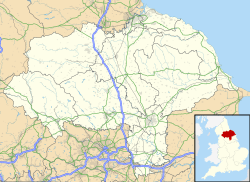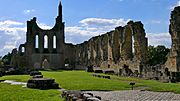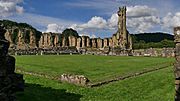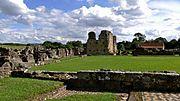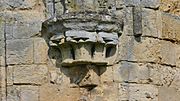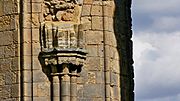Byland Abbey facts for kids
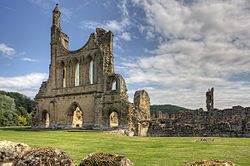 |
|
| Monastery information | |
|---|---|
| Order | Savigniac, Cistercian 1148 |
| Established | 1155 |
| Disestablished | 1538 |
| Diocese | Diocese of York |
| People | |
| Important associated figures | Abbot Roger, Roger de Mowbray |
| Site | |
| Location | Byland, Coxwold, North Yorkshire, England |
| Coordinates | 54°12′11″N 1°09′33″W / 54.2031°N 1.1592°W |
| Visible remains | substantial |
| Public access | yes |
Byland Abbey is a fascinating ruined abbey and a small village in the Ryedale area of North Yorkshire, England. You can find it within the amazing North York Moors National Park. This ancient place has a long and interesting history, full of challenges and unique stories.
Contents
The Story of Byland Abbey
Byland Abbey started as a special kind of monastery called a Savigniac abbey in January 1135. Monasteries were places where monks lived and prayed. Later, in 1147, it joined the Cistercian order, which was another group of monks.
The monks had a tough start! They had to move five times before they finally settled in a place called New Byland, near Coxwold, in 1177.
Early Challenges and Success
In its early days, Byland Abbey had arguments with four other religious places nearby. These were Furness Abbey, Calder Abbey, Rievaulx Abbey, and Newburgh Priory. Even with these problems, Byland Abbey became very important. By the late 1300s, people called it "one of the three shining lights of the north." This meant it was a very respected and important place.
Byland Abbey wasn't as rich as some other abbeys like Rievaulx. But it was famous for raising sheep and selling wool. Its church was also known as one of the most beautiful churches from the 1100s in all of Europe.
A Royal Visit and a Battle
In October 1322, King Edward II was staying at Byland Abbey. Suddenly, a battle called the Battle of Old Byland happened nearby! Scottish fighters surprised King Edward. He had to quickly escape to York, leaving many valuable things behind at the abbey.
The End of the Abbey
In the late 1100s, the abbey had 36 monks and 100 lay brothers. Lay brothers were people who lived and worked at the abbey but weren't monks. However, by November 1538, when the king decided to close down many monasteries (this was called the Dissolution), Byland Abbey only had 25 monks and an abbot (the head monk).
In 1539, the land where the abbey stood was given to a man named Sir William Pickering.
Byland Abbey Today
Today, English Heritage looks after the abbey ruins. It's protected as an ancient monument by Historic England. It also has a special "grade I listed" status, which means it's a very important historical building. In 2017, parts of the church, including its famous Rose Window, were carefully repaired to fix water damage.
Medieval Ghost Stories
Did you know Byland Abbey was a place where books were made? Many old manuscripts (handwritten books) were created and kept there. Twenty-seven of these books still exist today.
One special book from Byland Abbey is famous for something spooky! It contains a collection of twelve ghost stories. This book was made between the 1100s and 1200s. Then, in the early 1400s, an unknown monk from Byland added these ghost stories to some empty pages.
These stories were mostly set in the local area. They were probably used in sermons to teach lessons, and they show us what people in Yorkshire believed about ghosts back then. Even though they weren't famous at the time, these stories are now very important. They help us understand what people thought about ghosts in medieval Europe.
What You Can See Today
You can still see many impressive parts of Byland Abbey today. English Heritage takes care of the site. One amazing feature is the lower part of a huge rose window. This beautiful circular window actually inspired the famous rose window at York Minster!
Another cool thing to see is some of the brightly colored medieval floor tiles. These tiles have been preserved and show how colorful the abbey once was. A stone base for a lectern (a stand for reading) from the chapter house is also there. It's the only one of its kind found in Britain!
Gallery


